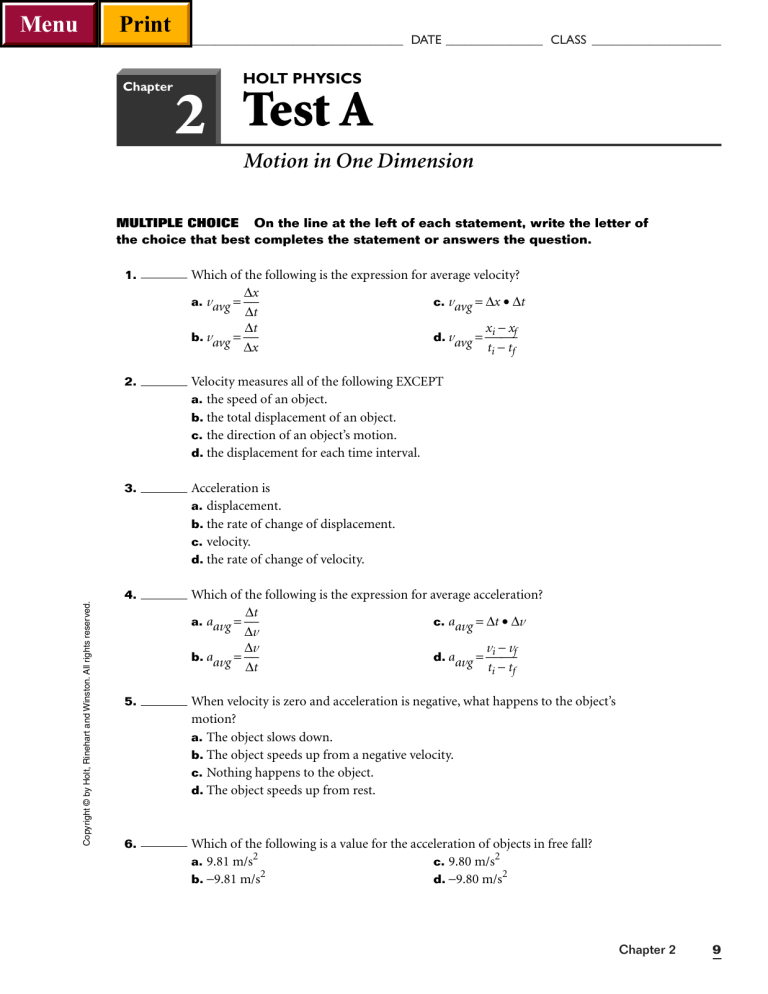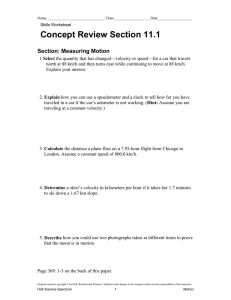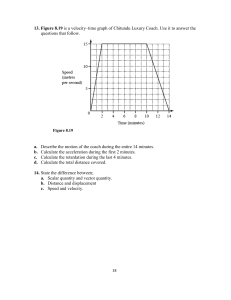
Menu Print NAME ______________________________________ DATE _______________ CLASS ____________________ Chapter HOLT PHYSICS 2 Test A Motion in One Dimension Copyright © by Holt, Rinehart and Winston. All rights reserved. MULTIPLE CHOICE On the line at the left of each statement, write the letter of the choice that best completes the statement or answers the question. 1. Which of the following is the expression for average velocity? ∆x a. vavg = c. vavg = ∆x • ∆t ∆t ∆t xi − xf b. vavg = d. vavg = ∆x ti − tf 2. Velocity measures all of the following EXCEPT a. the speed of an object. b. the total displacement of an object. c. the direction of an object’s motion. d. the displacement for each time interval. 3. Acceleration is a. displacement. b. the rate of change of displacement. c. velocity. d. the rate of change of velocity. 4. Which of the following is the expression for average acceleration? ∆t a. aavg = c. aavg = ∆t • ∆v ∆v ∆v vi − vf b. aavg = d. aavg = ∆t ti − tf 5. When velocity is zero and acceleration is negative, what happens to the object’s motion? a. The object slows down. b. The object speeds up from a negative velocity. c. Nothing happens to the object. d. The object speeds up from rest. 6. Which of the following is a value for the acceleration of objects in free fall? a. 9.81 m/s2 c. 9.80 m/s2 2 b. −9.81 m/s d. −9.80 m/s2 Chapter 2 9 Menu Print NAME ______________________________________ DATE _______________ CLASS ____________________ 2 HOLT PHYSICS continued Test A 7. The baseball catcher throws a ball vertically upward and catches it in the same spot as it returns to the mitt. At what point in the ball’s path does it experience zero velocity and nonzero acceleration at the same time? a. midway on the way up b. at the top of its trajectory c. the instant it leaves the catcher’s hand d. the instant before it arrives in the catcher’s mitt 8. When there is no air resistance, objects of different masses a. fall with equal accelerations with similar displacements. b. fall with different accelerations with different displacements. c. fall with equal accelerations with different displacements. d. fall with different accelerations with similar displacements. 9. Which would fall with greater acceleration in a vacuum, a leaf or a stone? a. the leaf b. the stone c. They would accelerate at the same rate. d. It is difficult to determine without more information. 10. A dolphin can swim 1.85 km/h. How far does the dolphin travel after 0.60 h? a. 1.1 km c. 0.63 km b. 2.5 km d. 3.7 km 11. A cheetah can maintain its maximum speed of 27.8 m/s for only 30.0 s. What is the minimum distance a gazelle running at 22.2 m/s must be ahead of the cheetah to have a chance of escaping? a. 100.0 m c. 70.0 m b. 168 m d. 83.0 m 12. A toy car is given an initial velocity of 5.0 m/s and experiences a constant acceleration of 2.0 m/s2. What is the final velocity after 6.0 s? a. 10.0 m/s c. 16 m/s b. 12 m/s d. 17 m/s 13. A marble accelerates from rest at a constant rate and travels for a total displacement of 44 m in 20.0 s. What is the average velocity of the marble? a. 1.1 m/s c. 4.4 m/s b. 2.2 m/s d. 0.0 m/s 10 Holt Physics Chapter Tests Copyright © by Holt, Rinehart and Winston. All rights reserved. Chapter Menu Print NAME ______________________________________ DATE _______________ CLASS ____________________ Chapter 2 HOLT PHYSICS continued Test A 14. A rock is thrown from the top of a cliff with an initial speed of 12 m/s. If the rock hits the ground after 2.0 s, what is the height of the cliff? (Disregard air resistance, g = 9.81 m/s2.) a. 22 m c. 44 m b. 24 m d. 63 m 15. A tourist accidentally drops a camera from a 40.0 m high bridge. If g = 9.81 m/s2 and air resistance is disregarded, what is the speed of the camera as it hits the water? a. 28.0 m/s c. 56.0 m/s b. 31.0 m/s d. 784 m/s SHORT ANSWER provided. Write the answers to the following questions in the space Copyright © by Holt, Rinehart and Winston. All rights reserved. 16. What is free fall? 17. Why is the direction of free-fall acceleration negative? Chapter 2 11 Menu Print NAME ______________________________________ DATE _______________ CLASS ____________________ HOLT PHYSICS continued Chapter 2 Test A Displacement (m) PROBLEM Write your answer to the question on the line to the left and show your work in the space provided. 10 9 8 7 6 5 4 3 2 1 A B C 1 2 3 4 5 6 7 8 9 0 Elapsed Time (s) The graph above shows displacement versus time. What is the average velocity for line A? 18. GRAPH Displacement (m) 1.0 2.0 3.0 4.0 5.0 Time (s) 2.0 4.0 6.0 8.0 10.0 19. Construct a graph of position versus time using the data in the table above. What value is 20. A motorized scooter starts at rest and accelerates for 4 s at 2 m/s2. It continues at a constant speed for 6 s. Graph velocity versus time to describe this motion. 12 Holt Physics Chapter Tests Copyright © by Holt, Rinehart and Winston. All rights reserved. represented by the slope of a graph? Find the slope between ∆t = 1 s and ∆t = 2 s. Be sure to use appropriate SI units. Menu Print NAME ______________________________________ DATE _______________ CLASS ____________________ Chapter HOLT PHYSICS 2 Test B Motion in One Dimension MULTIPLE CHOICE On the line at the left of each statement, write the letter of the choice that best completes the statement or answers the question. Copyright © by Holt, Rinehart and Winston. All rights reserved. 1. What is the speed of an object at rest? a. 0.0 m/s b. 1.0 m/s c. 9.8 m/s d. 9.81 m/s 2. In addition to displacement, which of the following must be used for a more complete description of the average velocity of an object? a. m c. ∆t b. kg d. ∆x 3. Which of the following is the expression for average acceleration? ∆t a. aavg = c. aavg = ∆t • ∆v ∆v ∆v vi − vf b. aavg = d. aavg = ∆t ti − tf 4. When velocity is positive and acceleration is negative, what happens to the object’s motion? a. The object slows down. b. The object speeds up. c. Nothing happens to the object. d. The object remains at rest. 5. If a baseball has a negative velocity and a negative acceleration, the velocity a. increases. c. slows to rest. b. decreases. d. speeds up from rest. 6. Which of the following units are used to measure acceleration during free fall? a. m/s c. m • s 2 b. m/s d. m2/s2 7. Acceleration due to gravity is also called a. negative velocity. b. displacement. c. free-fall acceleration. d. instantaneous velocity. Chapter 2 13 Menu Print NAME ______________________________________ DATE _______________ CLASS ____________________ 2 HOLT PHYSICS continued Test B 8. The baseball catcher throws a ball vertically upward and catches it in the same spot as it returns to the mitt. At what point in the ball’s path does it experience zero velocity and nonzero acceleration at the same time? a. midway on the way up b. at the top of its trajectory c. the instant it leaves the catcher’s hand d. the instant before it arrives in the catcher’s mitt 9. Which would hit the ground first if dropped from the same height in a vacuum, a feather or a metal bolt? a. the feather b. the metal bolt c. They would hit the ground at the same time. d. They would be suspended in a vacuum. 10. Which would fall with greater acceleration in a vacuum, a leaf or a stone? a. the leaf b. the stone c. They would accelerate at the same rate. d. It is difficult to determine without more information. 11. A hiker travels south along a straight path for 1.5 h with an average velocity of 0.75 km/h, then travels south for 2.5 h with an average velocity of 0.90 km/h. What is the hiker’s displacement for the total trip? a. 1.1 km to the south c. 3.4 km to the south b. 2.2 km to the south d. 6.7 km to the south 12. A trucker drives with an average velocity of 27 m/s toward the east on a perfectly straight highway. What will the trucker’s displacement be after 2.0 h? a. 97 km to the east c. 1.6 × 102 km to the east b. 1.9 × 102 km to the east d. 3.2 × 102 km to the east 13. A shopping cart is given an initial velocity of 2.0 m/s and experiences a constant acceleration of 3.0 m/s2. What is the magnitude of the cart’s displacement after the first 4.0 s of its motion? a. 10.0 m c. 32 m b. 55 m d. 80.0 m 14. A soccer ball is kicked horizontally. What is its average speed if after 4.00 s its displacement is 21.0 m? a. 5.25 m/s c. 14.4 m/s b. 8.75 m/s d. 0.00 m/s 14 Holt Physics Chapter Tests Copyright © by Holt, Rinehart and Winston. All rights reserved. Chapter Menu Print NAME ______________________________________ DATE _______________ CLASS ____________________ Chapter 2 HOLT PHYSICS continued Test B Human reaction time is usually about 0.20 s. If your lab partner holds a ruler between your finger and thumb and releases it without warning, how far can you expect the ruler to fall before you catch it? (Disregard air resistance. g = 9.81 m/s2.) a. at least 4.0 cm c. at least 16.0 cm b. at least 9.8 cm d. at least 19.6 cm 15. SHORT ANSWER provided. Write the answer to the following question in the space 16. What is the acceleration of an object thrown upward? What is its acceleration as it free falls? Displacement (m) Copyright © by Holt, Rinehart and Winston. All rights reserved. PROBLEM Write your answers to the questions on the line to the left and show your work in the space provided. 10 9 8 7 6 5 4 3 2 1 0 A B C 1 2 3 4 5 6 7 8 9 Elapsed Time (s) 17. The graph above shows displacement versus time. What is the average velocity for line B? Chapter 2 15 Menu Print NAME ______________________________________ DATE _______________ CLASS ____________________ Chapter 2 HOLT PHYSICS continued Test B A pair of spectacles is dropped from the top of a 32.0 m high stadium. A pen is dropped 2.0 s later. How high above the ground is the pen when the spectacles hit the ground? (Disregard air resistance. g = 9.81 m/s2.) 18. GRAPH Displacement (m) 2.0 3.5 6.0 Time (s) 0.0 4.5 10.0 19. Construct a graph of position versus time using the data in the table above. What value is 20. A motorized scooter starts at rest and accelerates for 4 s at 2 m/s2. It continues at a constant speed for 6 s. Graph velocity versus time to describe this motion. 16 Holt Physics Chapter Tests Copyright © by Holt, Rinehart and Winston. All rights reserved. represented by the slope of a graph? Find the slope between ∆t = 1 s and ∆t = 2 s. Be sure to use appropriate SI units. Menu Print Chapter 2 Test Form A Chapter 2 Test Form B A B D B D B B A C A B D B C A Free fall is the motion of an object falling with a constant acceleration in the absence of air resistance. 17. The direction of the free-fall acceleration is negative because the object accelerates toward Earth (the usual choice of coordinates uses positive as the direction away from the Earth). 18. 3.0 m/s 1. 2. 3. 4. 5. 6. 7. 8. 9. 10. 11. 12. 13. 14. 15. 16. 1. 2. 3. 4. 5. 6. 7. 8. 9. 10. 11. 12. 13. 14. 15. 16. 19. A C B A B B C B C C C B C A D The direction of the free-fall acceleration is negative because the object accelerates toward Earth (the usual choice of coordinates uses positive as the direction away from the Earth). 17. 1.0 m/s 18. 3.0 × 101 m 19. 10 Displacement (m) Displacement (m) 5.0 4.0 3.0 2.0 1.0 8 6 4 1.0 2.0 3.0 4.0 5.0 6.0 7.0 8.0 9.0 10.0 Time (s) 0 velocity, 0.5 m/s 2 4 6 8 10 Time (s) 20. 20 18 16 14 12 10 8 6 4 2 0 Velocity (m/s) Velocity (m/s) 20. 1 2 3 4 5 6 7 8 9 10 Time (s) 20 18 16 14 12 10 8 6 4 2 0 1 2 3 4 5 6 7 8 9 10 Time (s) 202 Holt Physics Chapter Tests Copyright © by Holt, Rinehart and Winston. All rights reserved. 2 0



